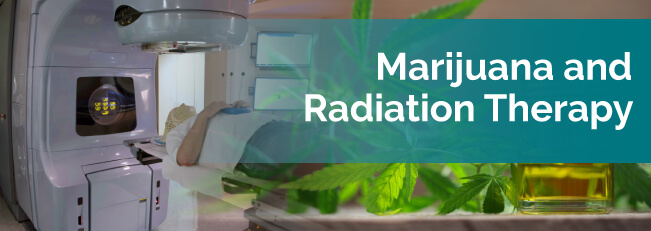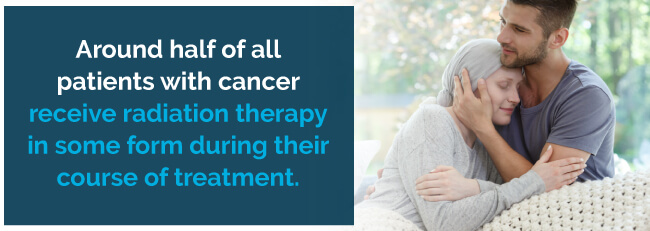
Over the last several years, more and more patients have realized the potential benefits of cannabis in treating cancer and alleviating the side effects its treatment causes. Sometimes, the side effects of cancer treatment, such as fatigue, nausea, lack of appetite, insomnia and depression, are more debilitating than the cancer itself. Medical marijuana for radiation therapy is gaining the interest of both researchers and patients as a way to ease some of these cancer treatment side effects.
Radiation therapy (also called radiation oncology) is a common type of cancer treatment utilizing x-rays or radionuclides to destroy cancer cells. This treatment method can ease cancer symptoms, control cancer and even cure it. However, it also comes with adverse side effects, such as nausea and vomiting, loss of appetite and pain. Although recent advances have resulted in new medications to help ease the side effects of radiation therapy, many patients prefer medical marijuana as a natural alternative medicine to treat these symptoms.
Find A Doctor Find A Dispensary

Countless studies have shown marijuana is effective for lessening the effects of cancer and radiation treatment. For example, the Office of National Drug Control Policy commissioned the Institute of Medicine(IOM) to assess the potential risks and health benefits of marijuana, and the IOM reported that the cannabinoids found in cannabis relieve pain, control nausea and vomiting, and stimulate the appetite.
Medical cannabis for radiation therapy is a natural alternative to other medications cancer patients use to prevent certain radiation therapy side effects such as:
It may also help you with any emotional/mental side effects like:
A host of cannabis and radiation therapy strains can ease your radiation therapy-related side effects mentioned above. The best for people going through cancer treatment is an indica strain called Master Kush — it’s beneficial for treating a range of radiation therapy-related side effects including anxiety, pain, depression, stress, lack of appetite, fatigue and more.
Other strains can treat specific symptoms individually, such as:
Nausea and Lack of Appetite: Sour Diesel (Sativa), White Widow (Hybrid), Elephant Bud (Indica), Super Lemon Haze (Sativa) and Blueberry Diesel (Hybrid)
Smoking the leaves or dried buds of cannabis is one of the most common ways to ingest medical weed. It’s fast, effective and allows you to feel the effects almost instantly. But, it’s probably not the healthiest way — after a while, it could do a number on your lungs. Other methods of marijuana and radiation therapy other than smoking include:
Medical Marijuana is an affordable, natural alternative to help thousands of cancer patients just like you prevent nausea, vomiting, weight loss and pain associated with radiation therapy. If you’re planning on or currently undergoing radiation therapy and would like to find out if medical marijuana is the right treatment for you, MarijuanaDoctors.com can help.
With our online calendaring and appointment scheduling portal, we make it easy for you to schedule a visit and get in touch with a dispensary. We can connect you with hundreds of quality marijuana doctors working with radiation therapy patients across the country in all legal marijuana states and ensure you comply with your state laws. Search for a medical marijuana doctor and book an appointment today so we can help improve your quality of life during and after radiation therapy.
Find A Doctor Find A Dispensary
Radiation therapy uses intense energy beams or x-rays to kill cancer cells. Other types of energy, such as protons and gamma rays, are also used in radiation.
This form of therapy is also known as external beam radiation therapy. With this type of radiation, a machine produces high-energy beams to target a precise area of your body. With brachytherapy, which is another type of radiation, the energy beam targets the insides of your body.
Radiation destroys genetic material inside your body to control the way your cells grow and divide, therefore damaging the cells. While radiation therapy damages both cancerous cells and healthy cells, the goal is to avoid destroying as many healthy, healthy cells as possible.
Physicians give you radiation therapy during various stages of your cancer treatment to produce different results. They give radiotherapy for reasons, including to:

Around half of all patients with cancer receive radiation therapy in some form during their course of treatment.
The primary purpose of radiotherapy is to kill cancer cells and shrink tumors. Even though the therapy does injure your healthy cells in the process, the damage isn’t usually permanent since healthy cells can recover from radiotherapy. Doctors target the radiation to specific areas of your body to minimize the effect of the radiation to your body.
Radiation therapy is an essential cancer treatment often combined with other remedies like tumor-removal surgery and chemotherapy.
If you’re about to start radiation therapy, you’re probably wondering how it will work. Your doctor will use a linear accelerator to direct high-energy radiation beams into your body during external beam radiation therapy. You’ll lie down on a table while the physician moves the linear accelerator around your body, delivering the radiation from different angles. The doctor adjusts the linear accelerator for your specific situation to ensure it provides the exact radiation dose needed. You’ll likely receive this therapy five days a week on an outpatient basis for a specified period. The physician spreads the treatments out over a few weeks so your healthy cells will have time to recover between sessions.

Each session lasts up to 30 minutes. While lying down, the doctor may use molds to hold you into position. Sometimes, you may only receive a single treatment to help with symptoms like pain if you’re in an advanced stage of cancer.
To reach an area of your body from a different direction, the doctor may rotate the linear accelerator around your body. During the treatment, you should breathe normally and lie still. You will hear a buzzing noise the machine makes. If you have breast or lung cancer, the doctor may ask you to hold your breath as he delivers treatment.
The doctor and radiation team will be in a room nearby while you receive treatment with audio and video connections to keep communication with you. Be sure to speak up if you’re uncomfortable with the treatment — your healthcare team is trained to help you through the therapy.
Ionizing radiation for cancer treatment goes as far back as the late 19th century, right after Roentgen gave a description of X-rays in 1895 and again in 1898, which eventually led to the use of brachytherapy. These first efforts aroused a revolution of technological and conceptual innovations for the entire 20th century to form the groundwork of the effective and safe therapies doctors use today. Since then, radiation therapy is now a standard treatment for a whole range of cancers and malignancies.
The type of radiotherapy you receive depends on certain factors, including:
There are two primary types of radiotherapy: internal and external beam.
With internal radiation therapy, the doctor puts a source of radiation inside your body. The radiation source is either liquid or solid.
Brachytherapy is the reliable source of internal radiation therapy. With this type, the doctor places ribbons, seeds or capsules containing the source of radiation into your body next to or in the tumor. Brachytherapy, like external beam radiation therapy, is a local treatment treating only certain body areas or parts.
Systemic therapy is the liquid source of internal radiation therapy where the treatment travels throughout your body in your blood tissues to seek out and kill cancer cells. Methods of systemic radiation therapy are through an IV line into your vein, or by swallowing it.
With external beam radiation therapy, the doctor uses a machine to direct the radiation at the cancer. The device doesn’t touch you, but moves around you from many directions, sending the radiation to different areas or parts of your body. It’s a local treatment, meaning it targets a specific body area. For instance, if your cancer is in your stomach, the doctor directs the radiation to your abdomen, not your entire body.
Due to the weak capacity of cancer cells self-repairing and the higher rate of healthy cell replication, radiation therapy targets more cancer cells than healthy cells. But, radiotherapy does affect some healthy cells which lead to uncomfortable side effects.
The side effects you experience will depend on the body part the doctor treats, the dose and type of radiation therapy they use and other factors like your overall health.
Short-term, or acute, side effects of radiotherapy may include:
Long-term side effects of radiation therapy may include:
Along with making you feel physically and emotionally drained, radiotherapy can affect your emotions and make you feel:
These types of feelings are common. It’s stressful to live with cancer and go through treatment. You may benefit from meeting other people who have cancer or joining a support group. Contact the American Cancer Society, or ask your cancer care team to refer you to a way of connecting with others who are also dealing with concerns and problems like yours.
You can’t predict how radiotherapy will affect you. You might only have a couple mild side effects caused by your treatment, or you may struggle with more severe side effects. Therefore, it’s a good idea to discuss possible radiation therapy side effects with your doctor so you know what to expect.
Radiation therapy statistics provided by the journal Cancer Epidemiol Biomarkers Prevention include:

If your doctor prescribes you radiotherapy, you’ll work closely with your physician or healthcare team specialized in this treatment. Before your treatment, it’s essential you talk with them about how radiation therapy may make you feel and how you can feel better.
After radiation therapy, current treatments may include:
You’ll schedule follow-up appointments with a radiation oncologist after your treatment ends. The radiation oncologist will:
You’ll require fewer follow-up appointments as your body heals.
To protect your health after you receive radiation therapy, you must take care of yourself. Talk with your cancer team about how to do this properly.
Some advice they may give you include:
You might also consider marijuana for radiation therapy side effects. Read on to learn about its benefits.